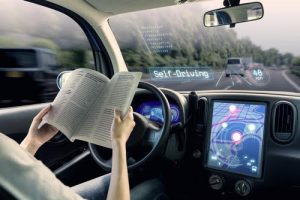By JW Law
It’s the year 2025. You just bought a shiny new driverless car and decided to take a ride. You enter your destination using voice control and head out of the city. As your car cruises down the highway, you catch up on your emails, sip a cup of coffee and listen to your favorite music. On the road, your car scans its surroundings, using a combination of cameras, detailed maps, radar, and adjusts its speed accordingly. Just as you get comfortable on your new ride- crash! – Your car strikes the driverless vehicle in front of you.
In normal circumstances, you would assess the damage, exchange insurance information, gather witnesses, and prepare for a legal battle. But this isn’t your typical accident. You were not in control of your car. So who is responsible for the damages? You? Your car manufacturer? Or the software programmer?
The above scenario may be imaginary, but injuries and deaths by autopilot systems (in semi-autonomous cars) are already a reality. Just last year a driver of a semi autonomous Tesla Model S was tragically killed when his car – in autopilot mode- rammed into the side of a tractor-trailer.
Tesla released a statement admitting that the car’s sensors failed to distinguish the large white truck against a bright sky. However, the company placed the blame on the driver stating that “the drivers need to keep their hands on the wheel to stop accidents like this from happening.” Soon after the incident, the car manufacturer announced that the company would not accept any liability for car crashes while in autonomous mode.
While other car manufacturers like Volvo, Google, and Mercedes have proactively pledged to accept full liability, they have not explained what “full liability” means.
“Since this technology is relatively new and just now being utilized on public roads, federal and state law is relatively silent on the subject.” said Jeffrey A. Rizika, Esq., who is chair of the Auto Committee for the New Jersey Association for Justice (NJAJ), the largest trial lawyer organization in New Jersey and whose practice includes automobile, truck, and bus litigation. “However, at this stage, all parties will likely be sharing the fault to some extent for such crashes.”
Driverless cars are touted to bring a lot of benefits. They can empower those who are unable to drive themselves, make commutes more productive, reduce traffic, and most importantly, dramatically reduce traffic fatalities by taking human errors and emotions out of the equation. The National Transportation Safety Board estimated that driverless cars could save many, if not most of the 32,000 lives lost every year. However, robot cars are not completely immune to accidents, and therefore the question of responsibility for accidents remains. So who exactly is responsible for accidents?
The U.S. National Highway Traffic Safety Administration (NHTSA) in response to a letter from Google, wrote that “If no human occupant of the vehicle can actually drive the vehicle, it is more reasonable to identify the driver as whatever (as opposed to whoever) is doing the driving.”
Does this mean victims can sue the automaker for accidents? “Each incident will require a separate analysis of the factors that resulted in the crash, how much control each potential defendant had to avoid the crash and what the reasonable expectations were of the parties involved,” explains Rizika. However, some lawmakers, car companies, and auto industry advocates are already pushing for measures that will let car manufacturers off the hook. In a report released earlier this year, the American Association for Justice (AAJ) warned that some regulatory proposals to ensure safety and accountability would, in fact, give robot car manufacturers legal immunity. In the report, titled: “Driven to Safety: Robot Cars and the Future of Liability,” AAJ also outlined potential safety gaps that could place the public at risk and recommended policies that the civil justice system, rather than regulators, legislators or the industry itself, serves as the primary forum for determining safety requirements and liability for failing to protect the public.
The vision of bringing driverless cars to the marketplace is slowly becoming a reality. Although this technology potentially offers benefits to the public, it also poses a very dangerous potential problem due to flaws that have not yet been worked out and the confusion that surrounds the usage of such vehicles. The attorneys at Javerbaum Wurgaft are dedicated to protecting the public against wrongful acts perpetrated against them and seeing that justice is done. If you have been injured in an accident involving a vehicle utilizing this new technology, please contact Mr. Rizika and the rest of the motor vehicle negligence team at Javerbaum Wurgaft. We are here to help.
[Read Related: WHO PAYS YOUR MEDICAL BILLS WHEN YOU ARE INJURED IN A CAR WRECK? IT IS NOT AS CLEAR AS YOU MAY THINK]